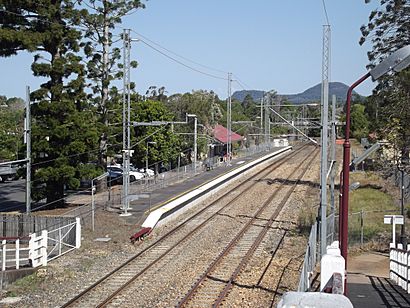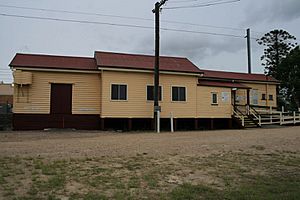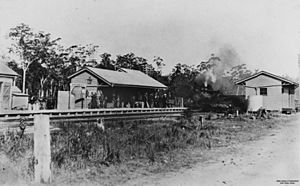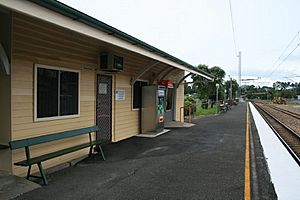Cooroy railway station facts for kids
Quick facts for kids
Cooroy
|
|||||||||||||||||||||||||||||
|---|---|---|---|---|---|---|---|---|---|---|---|---|---|---|---|---|---|---|---|---|---|---|---|---|---|---|---|---|---|

Southbound view in September 2012
|
|||||||||||||||||||||||||||||
| Location | Elm Street, Cooroy | ||||||||||||||||||||||||||||
| Coordinates | 26°25′03″S 152°54′40″E / 26.4176°S 152.9112°E | ||||||||||||||||||||||||||||
| Owned by | Queensland Rail | ||||||||||||||||||||||||||||
| Operated by | Queensland Rail | ||||||||||||||||||||||||||||
| Line(s) | North Coast | ||||||||||||||||||||||||||||
| Distance | 130.99 kilometres from Central | ||||||||||||||||||||||||||||
| Platforms | 1 | ||||||||||||||||||||||||||||
| Tracks | 2 | ||||||||||||||||||||||||||||
| Construction | |||||||||||||||||||||||||||||
| Structure type | Ground | ||||||||||||||||||||||||||||
| Parking | 100 spaces | ||||||||||||||||||||||||||||
| Other information | |||||||||||||||||||||||||||||
| Status | Staffed morning peak | ||||||||||||||||||||||||||||
| Fare zone | go card 8 | ||||||||||||||||||||||||||||
| Website | Queensland Rail | ||||||||||||||||||||||||||||
| History | |||||||||||||||||||||||||||||
| Opened | 17 July 1891 | ||||||||||||||||||||||||||||
| Electrified | Yes | ||||||||||||||||||||||||||||
| Services | |||||||||||||||||||||||||||||
|
|||||||||||||||||||||||||||||
| Cooroy railway station | |
|---|---|

Cooroy railway station
|
|
| Location | 14 Myall Street, Cooroy, Shire of Noosa, Queensland, Australia |
| Design period | 1870s - 1890s (late 19th century) |
| Built | 1890-1916 |
| Architect | Office of the Chief Engineer of Queensland Rail |
| Official name: Cooroy Railway Station | |
| Type | state heritage (built) |
| Designated | 14 August 2008 |
| Reference no. | 602381 |
| Significant period | 1890s-1910s |
| Significant components | platform, railway station, crane / gantry, shed - goods |
| Builders | Fitzwilliam Williams |
| Lua error in Module:Location_map at line 420: attempt to index field 'wikibase' (a nil value). | |
Cooroy railway station is a historic train station in Cooroy, Queensland, Australia. It's located on the North Coast railway line, which connects many towns along Queensland's coast. The station was designed by the engineers at Queensland Rail and built in 1890. It officially opened on 17 July 1891. Cooroy railway station is so important that it was added to the Queensland Heritage Register in 2008.
Contents
About Cooroy Railway Station
Cooroy station is a busy hub for both local and long-distance train travel. It helps people get around the Sunshine Coast and beyond.
Train Services
Cooroy station has two daily local train services in each direction. These are part of the City network.
It is also a stop for several long-distance trains, known as Traveltrain services. These include:
- The Spirit of Queensland
- The Spirit of the Outback
- The Tilt Train services to Bundaberg and Rockhampton
Where Trains Go From Cooroy
Trains from Cooroy can take you to many places:
- Local Trains (Sunshine Coast line):
- To Brisbane Roma Street
- To Gympie North
- Long-Distance Trains (Traveltrain):
- To Brisbane Roma Street
- To Bundaberg
- To Rockhampton
- To Longreach
- To Cairns
Local Transport Links
Local buses also serve Cooroy station. Sunbus routes 631 and 632 connect Cooroy station to Noosa Junction, Nambour station, and Cooran. However, the bus times don't always match up with the train times.
A Look Back: Cooroy's History
The Cooroy railway station building, built between 1891 and 1916, is made of timber. It's one of only nine old timber country station buildings left on the North Coast Line. This line stretches all the way from Brisbane to Cairns. Only two of these stations, Cooroy and Yandina, still have their original goods shed and crane.
The station building is made of hardwood timber and has a sloped roof. This roof extends over the platform, giving shelter, and is held up by curved wooden supports. This style of station building was common in Queensland from about 1884 to 1906.
Early Days and Timber
Before Cooroy became a town, it was a major logging area. Timber cutters were active in the Noosa area from the mid-1860s. A sawmill was set up around 1870 to provide timber for the Gympie goldfield. As timber near the coast ran out, loggers moved further inland. The land around Cooroy was used by a sawmilling company until 1907. After that, the government bought the land and opened it up for people to settle.
After 1891, timber from Cooroy was sent by train to a sawmill in Bulimba. The railway line was very important for this. A line from Maryborough reached the Gympie goldfields in 1881. This line was extended to Cooran in 1889 and then to Cooroy in April 1891. At the same time, a line from Brisbane reached Cooroy in July 1891. This meant that Brisbane was connected to Gympie and Bundaberg, making it easy to transport timber from Cooroy to the Brisbane market. The North Coast line continued to be built until 1924, when Brisbane was finally linked to Cairns.
Growing the Station
Even though Cooroy railway station opened in 1891, the town itself wasn't officially planned until 1907. Town lots were sold in April 1908. Before 1908, there were only a few buildings near the station. But by 1910, Cooroy had banks, hotels, and many homes and shops. A butter factory opened in 1915. By 1920, Cooroy had 450 people, and its economy relied on dairy farming, timber, and bananas.
The station building was first extended in 1895 to add a goods shed. By 1897, Cooroy station had a station building, a side track for trains, a telegraph, and areas for loading timber. In 1899, a ladies' room was added. The fact that the station building was extended twice before the town was even surveyed shows how busy it was, either for timber or for tourists.
The station building was extended again around 1916. At this time, it no longer had a goods shed section. Instead, it had a ladies' room, a waiting shed, and an office. A signal cabin was also added, making the building its current length. The station building was also moved to its current spot across from the goods shed. A crane was added by 1916.
Since 1916, only small changes have been made. A small alcove was added, and a ramp was built for easier access. The old ladies' room is now divided into men's and women's toilets. The goods shed looks much the same as it did in 1911.
Other changes over the years included adding telephones in 1909 and gas lights in 1920. Post and telegraph services were available at the station between 1892 and 1911. The platform was made longer in 1913. In 1915, a new loop siding was added for the butter factory. The current wooden footbridge, which crosses over the tracks, was built around 1985.
A Tourist Stop
Cooroy railway station was also a popular stop for tourists from 1891 onwards. The North Coast line made it easier for people to visit the beaches and mountain resorts of the North Coast, now known as the Sunshine Coast.
Before the Bruce Highway was built in the 1930s, people usually took the train to reach different holiday spots. For example, they would go to:
- Landsborough for Maleny or Caloundra
- Palmwoods for Montville, Buderim, Mooloolaba, Alexandra Headland, and Maroochydore
- Nambour for Mapleton, Maroochydore, or Coolum
- Cooroy for Tewantin and Noosa Heads
At Cooroy, passengers could switch from the train to horse-drawn coaches or cars. They would travel by road to Tewantin, and then catch a boat to Noosa. This made Cooroy a key link for tourists wanting to explore the Noosa area.
What the Station Looks Like
The main station area is surrounded by Diamond Street, Elm Street, Myall Street, and Maple Street. The station building is located near the northern end of the railway yard, on the east side of the North Coast railway line. The goods shed and a crane are on the opposite side of the tracks.
The Main Building
The station building has a sloped roof made of corrugated iron. The roof extends over the platform on the west side, creating an awning. This awning is held up by curved timber brackets. The building is about 22.6 meters long and is covered with weatherboards.
From north to south, the building includes:
- A section with male and female toilets.
- A waiting shed, where passengers can wait for their trains.
- An office, where tickets might have been sold.
- A former signal cabin, which was used to control train signals.
The main entrance to the station building has stairs and a ramp leading up to the east side of the waiting shed. Next to the station building is a concrete platform, which is covered with bitumen.
Goods Shed and Crane
The goods shed also has a sloped corrugated iron roof and is covered with weatherboards. Small eaves (the parts of the roof that hang over the walls) are supported by straight timber brackets. A timber loading dock runs along the east and south sides of the shed. This dock extends to where a whip crane is located. The shed has sliding doors and windows on its sides. Inside, you can see the exposed ceiling beams and wall studs. There's also a small office or workshop area inside.
Why Cooroy Station is Special
Cooroy railway station was added to the Queensland Heritage Register in 2008. This means it's considered a very important historical site in Queensland.
Showing History
Cooroy railway station is important because it shows how Queensland's history developed. It demonstrates how the North Coast line was extended in the late 1800s and early 1900s. This line connected major towns like Gympie, Maryborough, Bundaberg, and Brisbane. This connection helped with timber transport and the growth of farming (especially dairy) in the area. The station building was extended several times, which shows how much it was used during this period. Cooroy was also a key place for tourists traveling to Tewantin and Noosa from 1891 until the mid-1930s.
Unique Features
The way the station building, its platform, and the goods shed with its timber platform and metal crane are set up shows how a busy country railway station worked. The design of the Cooroy station building, with its toilets, waiting shelter, ticket office, and signal cabin, is also a good example of the standard designs used by Queensland Railways in the late 1800s and early 1900s.
The Cooroy station building hasn't changed much since it was extended in 1916. Its goods shed, built around 1910, is also in almost original condition. It's one of only nine surviving 19th-century country railway station buildings on the North Coast railway line. Only two of these stations, Yandina and Cooroy, still have their goods shed and crane.



